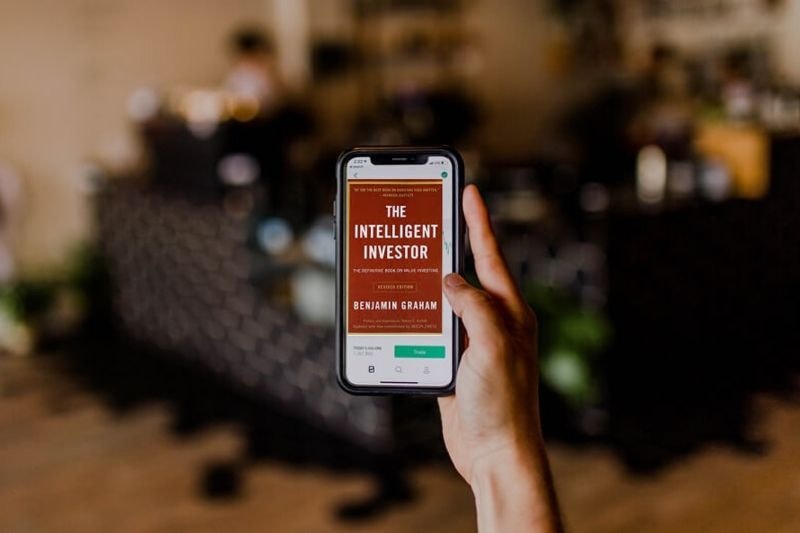Benjamin Graham was one of the greatest practical investment thinkers of all time. After his widowed mother lost all of their money in the financial crash of 1907, his family fell into poverty. Yet, Graham turned this around. Studying at Columbia University, he went on to work at Wall Street, going from clerk to analyst to partner before running his own investment partnership. Consequently, he amassed a wealth of historical and psychological knowledge concerning the financial markets, that spanned several decades. And he shared that knowledge in his book, The Intelligent Investor.

In ‘The Intelligent Investor,’ little time is spent discussing the technique of analyzing securities. Instead, great focus is placed on investment principles and investors’ attitudes. Although ‘The Intelligent Investor’ was first published in 1949, the underlying principles of good investment do not change from decade to decade. Consequently, in ‘The Intelligent Investor,’ Benjamin Graham aims to teach us three things:
- How to minimize the chances of suffering irreversible losses
- How to maximize the chance of achieving sustainable wins
- How to overcome self-defeating modes of thought that often prevent investors from reaching their full potential
To be an intelligent investor, you must be patient, disciplined, and eager to learn new things. You must also be able to control your emotions and to think for yourself. Graham states that the intelligence needed to be a good investor has much more to do with character than it does IQ. Throughout this ‘The Intelligent Investor’ summary, we shall explore some of the key investment takeaways, and the Benjamin Graham formula for smart, successful investing.
Post Contents
- ‘The Intelligent Investor’ Review – a Detailed Chapter Analysis
- Investment versus speculation
- Investment and Inflation
- A century of stock-market history
- The active and the defensive investor
- The defensive investor and common stocks
- Portfolio policy for the aggressive investor – the negative side
- Portfolio policy for the aggressive investor – the positive side
- The investor and market fluctuations
- Investing in investment funds
- The intelligent investor and their advisors
- Security analysis for the lay investor
- Things to consider about per-share earnings
- Stock selection for the defensive investor
- Stock selection for the enterprising investor
- Margin of safety as the central concept of investment
- Want to Learn More?



‘The Intelligent Investor’ Review – a Detailed Chapter Analysis
Investment versus speculation

Graham is keen to mark out an important difference between investors and speculators (i.e., Wall Street brokers). According to Graham, intelligent investing consists of three things:
- A thorough analysis of a company and the soundness of its business practices before the purchase of any of its stock
- Making sure that you are protected against any severe losses
- Not aspiring to extraordinary results, but aiming for “adequate” performance
For an intelligent investor, money isn’t made simply by “following the market,” i.e., buying a stock, because its value has gone up, or selling a stock because its value has waned. Graham argues that the exact opposite is true, positing that stocks become riskier the more their value increases and vice versa.
Whereas an investor believes the market price is judged by established standards of value, a speculator bases all of their standards of value on the market price, which is a significant difference. An excellent way to check if the market is swaying your value-judgments is to ask yourself whether you would be happy to invest in a particular stock if you were unable to know its market price. That way, you have to rely on your intuition.
For this reason, it’s vital to point out that, unlike the speculator, the intelligent investor isn’t investing for quick wins. The only way to reach long-term investment goals is to make sustainable and reliable decisions that are not subject to the whims of the often volatile stock market.
Investment and Inflation

To understand inflation, we have to look at how it has fluctuated throughout time. When armed with the historical data, it’s clear to see that while interest rates do oscillate, the overall trend is that interest generally increases over time. However, forecasting what the interest rate is going to look like in the future is risky. We can never know for sure what the figure will be in the future, but it might be worth considering the interest rates of the previous 20 years, and using them as a springboard to forecast what might be probable in the future.
Nevertheless, just because the future is uncertain doesn’t mean that we should put all of our investments in either bonds or stocks purely because of the attractiveness of their current interest rate. The more an investor begins to rely on the income gained from their portfolio, the greater their need to protect themselves from the unexpected. This means investing in the broader spread of both bonds and stocks.
Since ‘The Intelligent Investor’ was first published, two additional investment options have become available that protect investors from the risks of inflation. These are:
- 1. REITs (Real Estate Investment Trusts): Companies that own and collect rent from both residential and commercial properties.
- 2. TIPS (Treasury Inflation-Protected Securities): US government bonds that automatically increase in value as inflation rises.
A century of stock-market history

At the time of writing the reupdated version of “The Intelligent Investor,” it was 1973, and Benjamin Graham had managed to predict the disastrous bear market of 1973-74 in which US stocks lost 37 percent of their value. However, he unequivocally states that the intelligent investor doesn’t rely exclusively on historical data to predict the future.
To prevent us from taking such a purely historical-focused approach, Graham posits that we ask ourselves the following questions:
- Why should future returns always match past returns?
- If each investor believes that certain stocks are guaranteed to make money in the long-run, then doesn’t that mean that the market will end up becoming overpriced?
- If this is the case, then how is it possible for future returns to be high?
As Graham points out, to use a market’s recent good returns as a platform from which to project future returns is risky; no stock can perform consistently well for all time. However, many investors fall into the trap of buying high because a stock seems secure, and then selling low when the stock inevitably falters. To counteract this phenomenon, we should adopt the Benjamin Graham formula that suggests we use the “rule of opposites” which posits that the more enthusiastic investors become about a stock option in the long-run, the more certain they are to be proved wrong in the short-run.
Ultimately, Graham states that the only thing an investor can be sure about when attempting to forecast future stock returns, is that they will probably turn out to be wrong. The singular truth that history teaches us is that the future is unpredictable. What’s more, it’s the people who seem to be the most certain about how the future will turn out that are the most surprised when it proves otherwise. Therefore, the key is to remain humble about your abilities to predict the future to prevent you from risking too much on it.
The active and the defensive investor

The aggressiveness of your portfolio depends less on the kinds of investments you make, and more on the type of investor you are. Benjamin Graham states that there are two ways to be an intelligent investor:
- To continually research, choose, and observe a mix of bonds, mutual funds, and stocks. Graham refers to this as the “active” or “enterprising” approach. It requires a lot of time and energy.
- To create a permanent portfolio that requires minimal further effort on your behalf and that runs on autopilot, but that doesn’t generate a lot of excitement as a result. Graham refers to this as the “passive” or “defensive” approach.
Both approaches are equally smart, but your success in either one of them requires you to know which approach better suits your personality. This is because you will need to stick with this approach for your entire investment lifetime and be able to keep both your emotions and your costs in check. For example, if you have plenty of time, are competitive, and enjoy an intellectual challenge, you might make for a better active investor. If, however, you don’t particularly enjoy thinking about money and prioritize a feeling of calm, you might be better suited to being a defensive investor.
As a defensive investor, you don’t alter your investment practices simply because your life circumstances change. Central to the Benjamin Graham formula of intelligent investing is to replace all guesswork and market predictions with discipline.
The defensive investor and common stocks

Graham posits that how defensive you should be as an investor depends on how much time and energy you are willing to put into developing your portfolio. Still, given the volatility of the stock market, why would a defensive investor ever invest in stocks as opposed to bonds? Because, as Graham mentioned in chapter two, due to the risk of inflation, to invest entirely in either stocks or bonds is to make yourself vulnerable. It, therefore, doesn’t matter how defensive an investor you are, you should always keep at least a portion of your money in stocks.
One of the biggest challenges that a defensive investor must combat is the belief that they can pick stocks without doing a lot of research beforehand. It’s essential that a sense of familiarity with a company doesn’t replace researching the company’s financial statements. As psychologists at the Carnegie Mellon University showed, the more familiar an individual feels they are with a subject, the more likely they are to exaggerate how much they know about it.
This phenomenon can be seen in the likes of a countless number of investors buying shares in Amazon.com simply because they frequently used its services. By replacing familiarity with thorough research, these investors failed to see that the stocks they were buying were overpriced. Therefore, the more familiar a stock is, the more likely it is to turn an intelligent defensive investor into a complacent one.
As a defensive investor, it’s also essential not to become excited by new market fluctuations that could induce a rash investment decision. The way a defensive investor both participates in and wins the race is by sitting still. According to Graham’s “dollar-cost averaging” approach, a defensive investor will regularly put a fixed amount of money into a particular investment, regardless of how the markets are performing in any given week. Indeed, a defensive investor may even decide to purchase their stocks via a broker or a financial planner. However, to stick to Graham’s mantra of avoiding complacency, the defensive investor must investigate whether such an adviser should be trusted beforehand.
Portfolio policy for the aggressive investor – the negative side

Benjamin Graham argues that for both the defensive and the aggressive investor, what you don’t do is just as important as what you do. In this chapter, Graham highlights some absolute essentials for those wanting to take the aggressive investor route. These include:
- Avoiding high-yield preferred stock as there is no cheap and wildly available method for mitigating the risks associated with such stock.
- Don’t die a trader’s death by getting stuck in a vicious cycle of continually buying and selling stocks per the fluctuations of the market. As is evidenced by thousands of investors who have fallen prey to this exaggerated form of “aggressive” investing, the more you trade, the less you keep. An investor who is unable to hold on to their stocks for more than a month or two is, therefore, doomed to fail.
- Don’t get conned by an attractive IPO (initial public offering) purely because there is a lot of hype surrounding it. The more hype there is, the more likely it’s that the stock is overpriced, and the more likely it is that you make a judgment call based on your emotions, as opposed to rational judgment.
Portfolio policy for the aggressive investor – the positive side

Graham puts forward four ways an aggressive investor will make their investments:
- Selling in high markets and buying in low markets
- Buying carefully considered growth stocks
- Buying bargain stocks
- Taking advantage of and buying into “special situations”
For an aggressive investor to make a sound investment, it must further be held accountable to the following two ideals:
- The decision to buy the stock must be grounded in solid reasoning
- It must not be popular with most other investors or speculators
Graham suggests three investment approaches which conform to this two-fold criteria. They are as follows:
1. Investing in a relatively unpopular large company

If we can take it as a given that the market habitually overvalues common stocks that have been showing remarkable growth, we can assume that it undervalues companies that are not performing quite as well. The key here is for the intelligent investor to locate the larger companies that are going through a temporary period of uncertainty.
Indeed, the intelligent investor should only become interested in a significant growth stock, not when it’s at its most popular, but when something goes wrong. This strategy gives investors the opportunity to, as Graham puts it, buy stocks in a “relatively unpopular large company” that are being sold at a meager price.
Take, for example, Johnson & Johnson, who in 2002, announced that federal regulators were investigating its books after claims of false record-keeping. This false record-keeping caused its stock to drop a considerable 16 percent in a single day. Smart investors bought up these stocks. When the company returned to its former standing, they’d made quite a bit of money.
2. Purchasing bargain issues
A bargain issue is a stock or bond that seems to be worth at least 50 percent more than what it’s selling for. To work out if an issue is a bargain, you must first attempt to estimate whether the stock’s future earnings outweigh the costs of the issue currently causing it to be undervalued. Secondly, you must evaluate the value of the business to a private owner which, again, is primarily worked out by projecting future earning potential. Graham refers to this approach as having courage within a depressed market by using the wisdom of value analysis.
3. Special situations

A typical “special situation” arises when a larger firm acquires a smaller firm. To make such an acquisition possible, and to get the shareholders of the smaller company onboard, the stocks are nearly always offered at a price considerably higher than the current price. Therefore, any investor smart enough to purchase shares or bonds in a company that is perhaps nearing bankruptcy, and thus selling cheaply, but that may have a chance of being bought out and increasing its stock value, could make a lot of money.
The investor and market fluctuations

For the majority of the time, the market accurately prices stocks, but occasionally, the price is significantly wrong. Graham explains why by conjuring up an image of the market as being “Mr. Market;” a frantic investor who pays too much for stocks when they are doing well and desperately tries to get rid of them when their price falls. It’s, therefore, important that the intelligent investor can view the market as a fallible, emotion-driven entity, that shouldn’t be blindly trusted, even though most people do.
While it’s undoubtedly a good idea to observe how the market is behaving, the intelligent investor should behave in a way that serves their interests, without getting caught up in the pull of dramatic market fluctuations. Graham argues that one of the great advantages of being an individual investor is that you can think for yourself. By allowing yourself to get lost in the behavior of the market, you forgo your greatest asset; objective, critical thought. While you can’t control how the market changes over time, you can control the following:
- Your brokerage costs (by trading seldomly, cheaply, and with patience)
- Your ownership costs (by rejecting mutual funds with high annual expenses)
- Your expectations (by grounding your return predictions in reality, not fantasy)
- Your risk (by diversifying, rebalancing, and choosing how many of your assets to put in the market)
- Your tax bills (by holding all of your stocks for a minimum of a year, and if possible, five years to keep your capital-gains liability low)
- Your behavior
Investing isn’t about beating others in an investment game; it’s about controlling your behavior and being in charge of your own game. If you’re planning on investing for at least 25 to 30 years, then the most logical investment approach is to buy every month automatically and to buy more whenever you get some extra money. The stock market is the best option for such a lifelong investment, and this type of meticulous, automatic investment, means that you are less likely to be tempted to make rash, volatile, market-driven decisions.
If stocks are doing well, you buy, if they fall, you buy, and over time, your investments will begin to add up steadily. Graham states that it would be better if we couldn’t see a market quotation for our stocks at all as then we would be spared the anguish caused by “other persons’ mistakes of judgment.” By putting your portfolio on autopilot, you avoid the mood swings of “Mr. Market” and can focus instead on your long-term financial goals.
Investing in investment funds

Though mutual funds make investing seem easy and affordable, they come with their problems. They often underperform, overcharge, and behave erratically. The intelligent investor must, therefore, choose very carefully before investing in a mutual fund. A group of financial scholars that studied mutual funds for half a century concluded that mutual funds tend to behave under the following:
- They do not choose stocks well enough to cover the costs of researching and trading them.
- The higher a mutual fund’s expenses, the lower its returns.
- The more frequently a mutual fund trades, the lower its returns.
- Mutual funds that are more volatile than others and are likely to remain volatile.
- Mutual funds that had high returns in the past are unlikely to keep these high returns for long.
However, armed with this knowledge concerning the fallibility of mutual funds, the intelligent investor is better equipped to discern a more solid mutual fund from a more volatile one. Further, mutual funds offer the intelligent investor an excellent means of diversifying their portfolio and freeing them up to do things besides endlessly analyzing the market and picking their stocks.
In general, an index fund that owns all the stocks in the market at any one time will beat the most selective funds in the long-run. While this isn’t a particularly exciting way to invest, if you can hold an index fund for 20 years or more, you’ll likely outperform the majority of professional and individual investors alike. Graham and Warren Buffett both agree that index funds are the single best choice for individual intelligent investors.
The intelligent investor and their advisors

Many investors take comfort from the second opinion of an excellent financial advisor. Whether it’s to get advice on the rate of returns or to have someone to blame when things go wrong, having an advisor can prove an essential asset in the intelligent investor’s arsenal. Indeed, there are specific scenarios in which seeking out an advisor might prove even more beneficial; these include:
- If your portfolio loses a significant amount of its value.
- If you struggle to keep and maintain a personal budget and are barely able to make ends meet, let alone begin saving.
- When your portfolio is over-diversified to the point of being completely chaotic.
- If you’ve recently gone through a significant life change, such as becoming self-employed, or if you need to look after your aging parents.
Yet, before you choose your advisor, you must first try to ascertain if you can trust them, and then you need to investigate and verify their credentials. When you find a match, a good financial advisor will be able to establish:
- A comprehensive financial plan
- An investment policy statement
- An asset-allocation plan
All three of these facets are the fundamentals from which reliable financial decisions are made, you must create them together. Do not invest anything until you are personally happy with the investment decisions that your advisor suggests.
Security analysis for the lay investor
It can be challenging to discern which factors determine whether you should be willing to pay for a stock or not, but Graham provides five qualities by which to measure the attractiveness of a stock option:
- The company’s long-term prospects. This quality requires the intelligent investor to look at least five years’ worth of the company’s annual reports and to answer two questions: Where are the company’s profits coming from, and what is making this company grow?
- The quality of a company’s management. A good company’s management will do what they say they will. They should be honest about their failures and take responsibility for them.
- The financial strength and structure of the company’s capital. Whether the company produces more cash than it consumes, and the managers reinvest this money to grow profits further.
- The company’s dividend record. Research the previous ten years of dividends history. If dividends have increased at a steady average of at least six to seven percent over the past ten years, that’s a good sign.
- The company’s current dividend rate.

The intelligent investor is aware of the lengths to which top executives and accountants occasionally go to make themselves very rich at the expense of the company and its shareholders. There are plenty of ways that financial reporting and “creative accounting” has made companies seem more financially attractive than they are.
For example, pro forma earnings originally aimed at projecting an honest picture of long-term earnings growth by accounting for short-term deviations and nonrecurring events. A pro forma statement might show how much a company could have made over the previous year if the company they just acquired had been with them for that entire year.
However, pro forma earnings can also be used in a more corrupt manner with companies showing how well they might have done if they hadn’t made such bad investment decisions. For example, in 2001, JDS Uniphase Corps presented its pro forma earnings as if it hadn’t paid $4 million in taxes, lost $7 million in bad stocks, and as if it hadn’t incurred $2.5 billion in merger and goodwill chargers. The intelligent investor will, therefore, ignore any pro forma earnings reports.
Companies may also prematurely recognize revenue that hasn’t entered its accounts yet, i.e., projecting yearly revenue based on the number of products produced and expected to sell, before they’ve sold. However, there are a few things the intelligent investor can do to try to ascertain whether the company they are about to invest in has a few red flags in its accounting methods:
- Read backwards–When reading a company’s financial reports, start on the last page, and read towards the beginning. Nearly everything a company won’t want you to read will be found in the back of the report.
- Read the notes–Always read the footnotes of the financial statement’s found in the annual report. Be sure to compare the footnotes to at least one firm that’s a close competitor.
- Read more–Especially if you are an enterprising investor, it’s wise to try to learn as much as possible about financial reporting to reduce the risk of you being misled by a dubious earnings statement.
Stock selection for the defensive investor
By definition, the defensive investor takes a low-risk, long-term approach to investing. The best tool invented for such low-maintenance stock investing is a low-cost index fund. However, some defensive investors do enjoy the intellectual challenge of picking some individual stocks. When this is the case, it’s advised that the defensive investor keeps 90 percent of their shares in an index fund, leaving ten percent to be invested in the stock market at will. To help defensive investors make smart stock investment decisions, Graham proposes the following criteria for stock selection:
- Adequate size. When Graham first wrote ‘The Intelligent Investor,’ he stated it was advisable to avoid investing in smaller companies. However, with the option to buy into mutual funds that specialize in small stocks today, it can also make financial sense to buy into smaller companies by way of a small company index fund.
- Strong financial condition. Graham defines financial strength as a diversified portfolio of stocks that’s current assets are at least double its current liabilities, and that’s long-term debt doesn’t exceed working capital.
- Earnings stability. A stock is strong if it has some earnings on the common stock in each of the previous ten years.
- Dividend record. Look for companies that pay dividends and that have a history of doing so.
- Moderate P/E ratio. Only choose stocks whose current price is no more than 15 times the average earnings over the past three years.
- Moderate price-to-book ratio. Multiply the P/E ratio by the price-to-book ratio. If the number is below 22.5, it’s likely to be a reasonably priced stock.
Stock selection for the enterprising investor
For most investors, picking individual stocks is inadvisable. Even most professionals do a lousy job. While a small percentage of investors do well at picking their own stocks, the majority would do better to invest defensively, in an index fund. However, for those who want to give enterprising investment a shot, Graham suggests to practice first, by spending a year tracking and picking stocks, but not investing any money. This way, you learn without incurring any significant debt.
After a year, measure your results against how you would have done if you had put your money in an index fund. If you found the process exhausting, or you picked bad stocks, it might be worth considering becoming a defensive investor. If, however, you enjoyed the process and made some good returns, Graham suggests assembling a selection of stocks, but limiting them to only ten percent of your entire portfolio. The rest should be invested in an index fund.
If you decide to invest this ten percent in the market, then you should look for stocks and industries that are temporarily unfashionable and, thus, offer the potential for big gains once the public perception changes. By checking comparable businesses, or the prices that similar such companies have been acquired for over the years, you can get a good idea of how much a company may be worth.
Next, it’s essential to look at who is running the company and to ask yourself: Are the company’s financial statements understandable, or are they full of unclear jargon? Good managers communicate a company’s current status-quo clearly and honestly. Another red flag is if a manager talks more about the stock price than the business. These are signs that a company isn’t performing as well as it may appear.
Above all, an enterprising investor must be both disciplined and consistent, resist changing their approach even when it seems unfashionable, and they should only focus on what they are doing, not what the market is doing.
Margin of safety as the central concept of investment

Losing money is an inevitability of investing. To be a smart investor, you need to ensure that you never lose the majority, or all, of your money. To give yourself a buffer, Graham suggests that you refuse to pay too much for an investment and, therefore, minimize the chances of your wealth completely disappearing. As he has repeated throughout the book, the greatest risk to our financial health isn’t the stocks, but ourselves. Risk resides not in the market, but in what kind of an investor we are.
According to the Nobel-prize-winning psychologist, Daniel Kahneman, we often fall prey to two modes of thinking when making a decision:
- Well-calibrated confidence (do I understand this investment as well as I think I do?)
- Correctly-anticipated regret (how much will I regret it if my analysis turns out to be wrong?)
To check whether your confidence is well-calibrated, consider asking yourself the following questions:
- What is my track record with making similar decisions?
- What is the track record of other people who’ve made similar decisions like?
- If I am buying, it means someone else is selling. How probable is it that I know something that the seller doesn’t know?
- If I am selling, someone else is buying. How probable is it that I know something that the buyer doesn’t know?
- How much does this investment need to go up by before I break even (including taxes and the costs of trading)?
To assess whether you are correctly anticipating your regrets, ask yourself:
- Based on the historical performance of similar investments, how much money might I stand to lose?
- Do I have other investments that could tide me over if this decision turns out to be bad?
- Am I putting too much of my capital at risk with this investment?
- Have I ever lost a lot of money on an investment before? How did it feel? Did I buy more, or did I bail out?
- Am I in control of my behavior, or am I relying on willpower to prevent me from panicking at the wrong time?
In conclusion, the probability of you making a bad investment during your investment-lifetime is 100 percent guaranteed. Graham is, therefore, adamant that the intelligent investor has ensured themselves against any losses that a bad investment may accrue. Many investors are so sure that they are right, they do little to protect themselves against the consequences of being wrong, and this is fatal for an investor.
However, by making sure your portfolio is permanently diversified, and that the fluctuations of the market never influence you, you can ensure that the fallout from your bad investment decisions will never be a total disaster. This means that you can continue investing with regularity, patience, and calm, as you gradually work your way towards your long-term financial goals.
You can buy the Intelligent Investor by Benjamin Graham on Amazon.



Want to Learn More?
- 10 Step Formula to Financial Freedom
- Rich Dad Poor Dad Book Summary
- Good to Great Book Summary
- How to Win Friends and Influence People Book Summary



